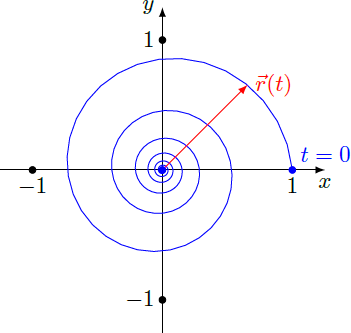Logarithmic spiral
A particle moves along a spiral so that its path is given by r ( t ) = e − α t ( cos ( t ) sin ( t ) ) , t ∈ [ 0 , ∞ ) with the time t and a decay constant α = 0 . 1 . What is the total distance of the path from r ( 0 ) = ( 1 , 0 ) to r ( ∞ ) = ( 0 , 0 ) , that is covered by the particle for all time?

The answer is 10.05.
This section requires Javascript.
You are seeing this because something didn't load right. We suggest you, (a) try
refreshing the page, (b) enabling javascript if it is disabled on your browser and,
finally, (c)
loading the
non-javascript version of this page
. We're sorry about the hassle.
1 solution
We can actually do it directly without calculating the velocity , but that solution is more lengthy than yours . For a function y = f ( x )
s = ∫ a b 1 + ( y ′ ) 2 d x
Log in to reply
In princple, you're right. I just thought it would be more obvious from a physical point of view to speak of a velocity. Furthermore, the spiral can not be uniquely represented by a function y = f ( x ) , since several (or even infinite) y values are associated with an x -value.
Log in to reply
you are absolutely correct , we cannot uniquely represent it as y = f ( x ) that is why we will integrate it in the parametric form .
d y = ( − α e − α t sin t + e − α t cos t ) d t d x = ( − α e − α t cos t − e − α t sin t ) d t
The end result is the integral s = 1 + α 2 ∫ 0 ∞ e − α t d t
The velocity of the particle is given by v ( t ) = r ˙ ( t ) = − α e − α t e r ( t ) ( cos ( t ) sin ( t ) ) + e − α t e ϕ ( t ) ( − sin ( t ) cos ( t ) ) = e − α t ( e ϕ ( t ) − α e r ( t ) ) with ∣ e r ∣ = ∣ e ϕ ∣ = 1 and e r ⋅ e ϕ = 0 . Therefore, the absolute value of the velocity results to v ( t ) = ∣ v ( t ) ∣ = v ( t ) ⋅ v ( t ) = 1 + α 2 ⋅ e − α t By integrating the velocity over time, the path length is obtained: s = ∫ 0 ∞ v ( t ) d t = 1 + α 2 ∫ 0 ∞ e − α t d t = α 1 + α 2 ≈ 1 0 . 0 5